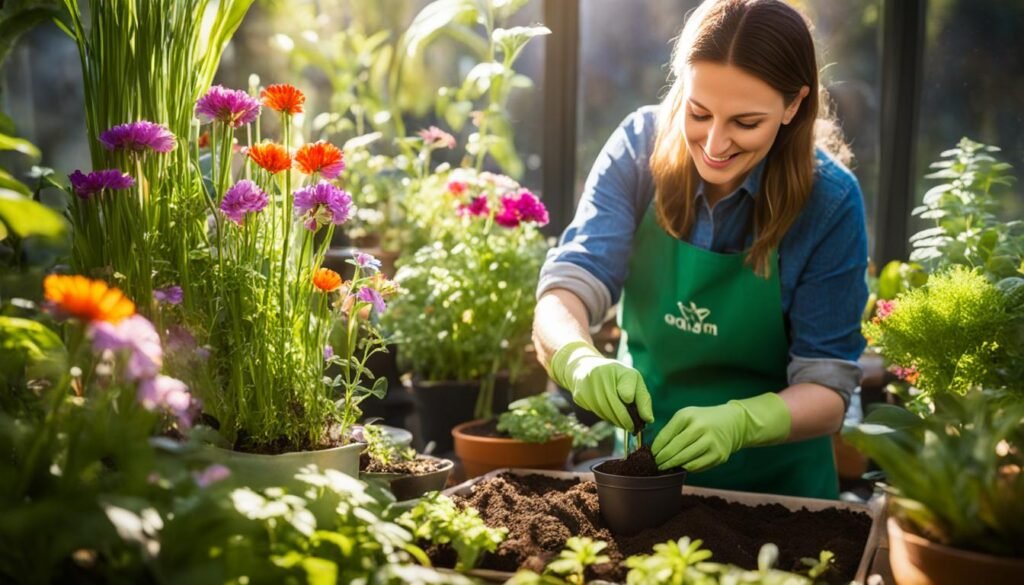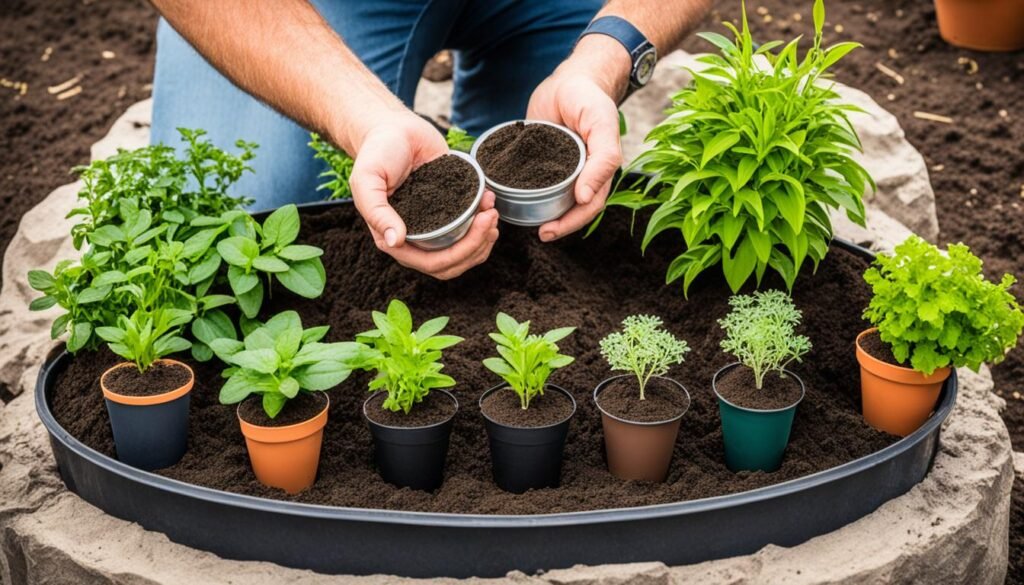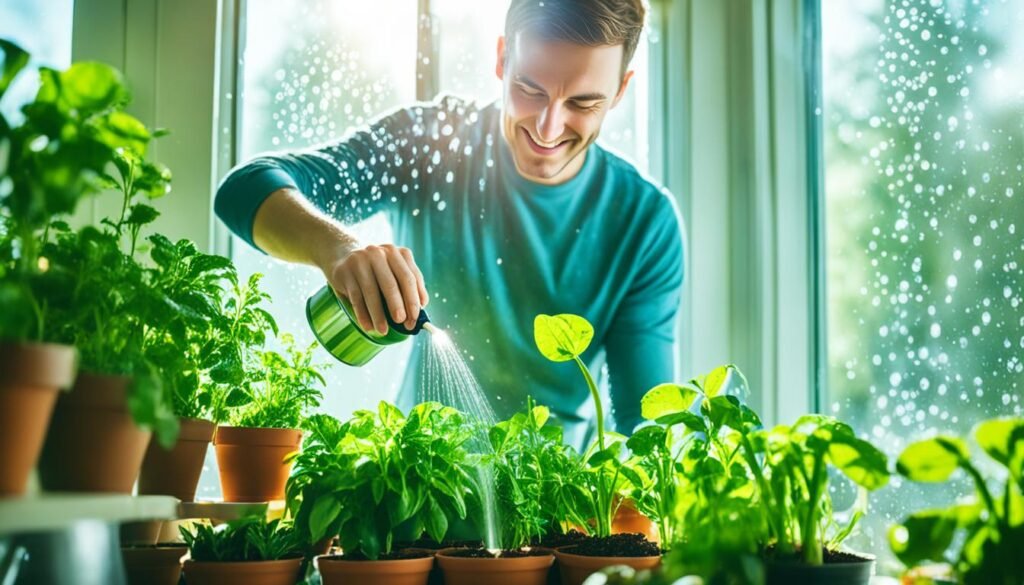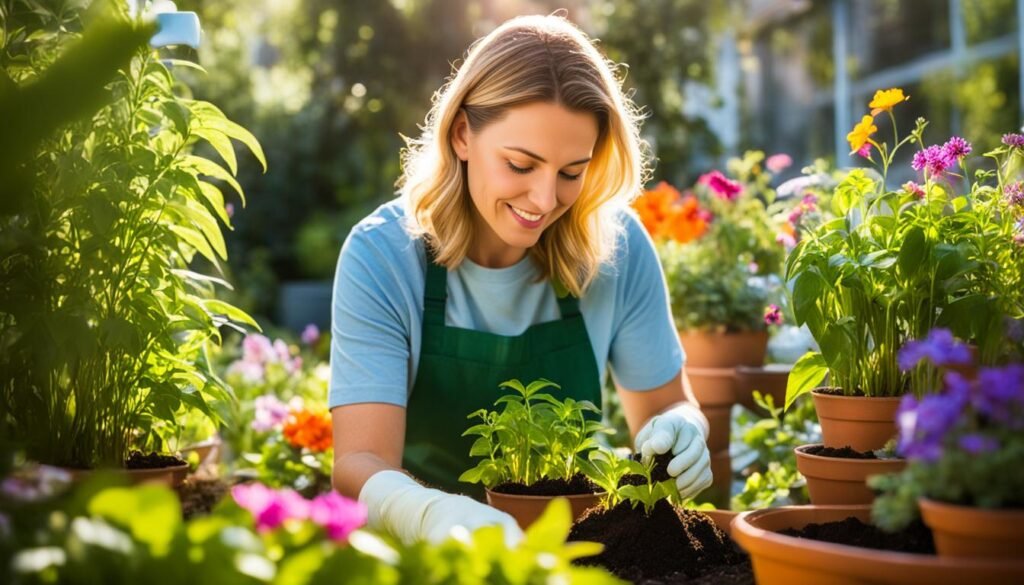Did you know that potting and planting are not only enjoyable hobbies but also have numerous benefits for your well-being and environment? Whether you’re a seasoned gardener or a beginner, understanding the art of potting and planting is essential for creating thriving indoor and outdoor greenery. From enhancing air quality to reducing stress levels, plants have a remarkable impact on our lives.

So, if you’re ready to dive into the world of potting and planting, I’m here to guide you through every step of the journey. Starting from choosing the right soil to providing ongoing care and maintenance, I’ll share expert advice, techniques, and a comprehensive potting guide to help your plants flourish.
Let’s harness the power of nature and transform your space into a lush oasis—both inside and out!
Choosing the Right Soil for Potting
One of the most crucial factors in successful potting is selecting the appropriate soil. To promote healthy growth, it is essential to use soil that is specifically formulated for potting and planting. Look for high-quality potting soil or potting mix that is enriched with nutrients and provides excellent drainage properties.
When choosing potting soil, consider opting for a blend that offers a balance of moisture retention and drainage. This will help prevent waterlogging and promote root health. Additionally, look for soil that is designed for the specific type of plants you will be potting. Some plants, such as succulents, prefer a well-draining soil mix, while others may thrive in a more moisture-retentive mix.
Reading the labels on the potting soil or potting mix is crucial to ensure it meets the requirements of your plants. Look for keywords such as “potting soil,” “potting mix,” “soil for potting,” or “planting soil” to ensure you are selecting the appropriate product. These soil blends are specifically designed to provide the necessary nutrients and structure for potted plants.
It is recommended to choose potting soil or potting mix that is enriched with organic matter, such as compost or peat moss. These additions help improve soil fertility and provide a rich source of nutrients for your plants.
When potting indoor or outdoor plants, remember that the soil is the foundation for their growth and overall health. Making the right soil choice will contribute to robust root development and optimum nutrient uptake. By selecting a suitable potting soil or potting mix enriched with essential nutrients, you can provide your plants with the best start for long-term success.
Selecting Suitable Containers for Potting
When it comes to potting your precious plants, the containers you choose play a significant role in their overall health and growth. That’s why it’s important to select suitable plant pots that provide the ideal environment for your green companions.
First and foremost, opt for plant pots that have drainage holes at the bottom. These holes allow excess water to escape, preventing waterlogged soil that can lead to root rot. Ensuring proper drainage is especially important for both indoor and outdoor plant pots.
It’s also crucial to choose containers that are the right size for your plants. Providing enough room for root growth is essential for their overall well-being. A pot that is too small can restrict root development and stunt the plant’s growth, while a pot that is too large may lead to overwatering or waterlogged soil. So, strike the perfect balance by selecting a pot that allows ample space for your plant’s roots to spread and grow.
Consider the material of the pots as well. Different materials have varying moisture retention properties. For example, clay pots tend to dry out more quickly, which is better for plants that prefer drier soil conditions. On the other hand, plastic or ceramic pots retain moisture for longer periods, ideal for plants that require consistent moisture levels.
By selecting plant pots with proper drainage, the right size, and suitable material, you are providing an optimal environment for your potted plants to thrive. Remember, happy plants start with the right container!
Step-by-Step Potting Guide

Follow this step-by-step potting guide to ensure proper potting technique:
- Choose the right container: Select a pot or container that provides enough space for the plant’s roots to grow. Ensure it has drainage holes at the bottom to prevent waterlogging.
- Add a drainage layer: Place a layer of small rocks or pottery shards at the bottom of the container to create a drainage system.
- Fill the container: Fill the container with potting soil, leaving enough space for the plant’s root ball.
- Prepare the plant: Gently remove the plant from its current container, loosen the roots, and remove any excess soil.
- Plant the greenery: Place the plant in the center of the container and add more potting soil around it, firming it gently to provide support.
- Water the plant: Give the plant a thorough watering, allowing water to flow through the drainage holes to ensure complete hydration.
- Place the container: Find a suitable spot for your potted plant, considering its light and temperature requirements.
- Provide ongoing care: Remember to water and fertilize your plant as needed, and monitor its growth and health regularly.
By following these potting instructions, you can ensure your plants have a strong start and the best conditions to thrive.
The Art of Planting

When it comes to gardening, planting is an essential skill that allows you to grow beautiful and vibrant plants. Whether you’re planting in your garden or creating a lush indoor oasis, mastering the art of planting will help your greenery thrive. Follow these tips and techniques to achieve successful outdoor and indoor planting:
1. Choose the Right Location
Before you start planting, select the ideal location for your plants. Consider factors such as sunlight, shade, and soil conditions. Outdoor plants usually require direct sunlight for a certain number of hours each day, while indoor plants may prefer bright, indirect light. Ensure that the soil is well-draining and rich in nutrients.
2. Prepare the Soil
Prepare the soil by removing any weeds or rocks and loosening it with a garden fork or tiller. Adding compost or organic matter can improve the soil’s fertility and drainage. This step is crucial for providing a healthy environment for your plants and promoting their growth.
3. Dig the Proper Hole
When planting, dig a hole that is slightly larger than the size of the plant’s root ball. Gently loosen the roots before placing the plant in the hole. Ensure that the plant is positioned at the same depth as it was in its original container or nursery pot.
4. Backfill and Firm the Soil
Backfill the hole with soil, gently pressing it around the plant roots to eliminate any air pockets. Firm the soil with your hands or the back of a garden tool to provide stability for the plant. Avoid compacting the soil too tightly, as it can hinder root growth.
5. Water Thoroughly
After planting, thoroughly water the soil around the plant to ensure good root-to-soil contact. This will help the plant establish itself and promote healthy growth. Monitor the moisture levels of the soil and water as needed, taking care not to overwater.
By following these planting techniques and being mindful of the specific needs of each plant, you can create a flourishing garden or indoor green space. Remember to regularly care for your plants by watering, fertilizing, and providing proper maintenance. Happy planting!
Watering After Potting/Planting

Proper watering is essential after potting or planting to ensure the plants receive enough hydration without being overwatered. After potting or planting, thoroughly water the plants until water begins to drain out of the bottom of the container or into the ground. This helps to establish good contact between the roots and the surrounding soil.
By providing adequate water at this crucial stage, you are giving your plants the best chance to settle into their new environment and promote healthy root development.
It’s important to monitor the moisture levels of the soil regularly and water as needed. Be mindful not to overwater, as excessive moisture can lead to root rot and other plant diseases.
Since watering needs vary depending on the specific plant and environmental conditions, it’s essential to observe your plants and make adjustments accordingly. For example, plants in hot, dry conditions may require more frequent watering, while those in cooler, shadier areas may need less.
Remember that it’s better to underwater than to overwater. Over time, you will become familiar with your plants’ individual watering needs, allowing you to provide the right amount of water at the right time.
Ongoing Care and Maintenance

Once your plants are potted or planted, ongoing care and maintenance are crucial for their health and growth. Taking the time to provide regular care will ensure that your greenery stays vibrant and beautiful.
Watering
Watering is an essential part of plant care, regardless of whether you have potted or planted plants. Each plant has specific water requirements, so it’s important to research and understand the needs of your individual plants. In general, you want to keep the soil moist but not waterlogged. One way to check if your plants need watering is to stick your finger about an inch into the soil. If it feels dry, then it’s time to water. Alternatively, you can use a moisture meter to help determine the soil’s moisture level.
Pruning and Trimming
Pruning and trimming are essential for maintaining the shape and health of your plants. Regularly inspect your plants for any dead, damaged, or diseased leaves, stems, or flowers. Use clean and sharp pruning shears to remove these unwanted parts. Additionally, you may need to trim back overgrown branches to promote healthy growth and maintain the desired size and shape of your plants.
Fertilizing
Fertilizing provides essential nutrients to your plants, promoting their overall health and growth. Choose a fertilizer specifically formulated for the type of plants you have. Follow the recommended dosage instructions, as over-fertilizing can harm your plants. Fertilize your potted or planted plants during their active growing season, typically in spring and summer. Remember to water your plants before and after applying fertilizer to prevent any potential root burn.
Pest and Disease Control
Regular monitoring for pests and diseases is essential to prevent any infestations or outbreaks that can harm your plants. Inspect your plants for any signs of insects, such as aphids or mealybugs, as well as any symptoms of diseases, such as leaf spots or wilting. If you notice any issues, take prompt action to control and treat the problem. There are various organic and chemical options available for pest and disease control, depending on the severity and type of issue.
By following these ongoing care and maintenance practices, you can provide the best possible environment for your potted or planted plants. Remember to research the specific care requirements of your individual plants and adapt your care routine accordingly. With proper care, your plants will flourish and bring beauty to your home or garden for years to come.
Conclusion
Potting and planting are essential gardening techniques for successful indoor and outdoor greenery. By following the potting tips, planting tips, and potting and planting advice provided in this article, you can ensure that your plants thrive and grow beautifully. Remember to choose the right soil, select suitable containers, follow a step-by-step potting guide, and provide ongoing care and maintenance. These potting and planting techniques will help you create a vibrant and flourishing garden.
Whether you’re an experienced gardener or just starting out, these potting and planting techniques will set you on the path to success. By selecting the appropriate potting soil and potting mix, you provide your plants with the nutrients and drainage they need for healthy growth. Choosing suitable containers with proper drainage ensures that your plants won’t become waterlogged.
Follow the step-by-step potting guide to ensure you’re potting your plants correctly, giving them the best chance to thrive. Watering after potting or planting is crucial, providing your plants with the necessary hydration without overwatering. And don’t forget about ongoing care and maintenance – regular watering, pruning, fertilizing, and pest monitoring are vital for the long-term health of your potted and planted plants.
By implementing these potting and planting techniques, you can create a beautiful and thriving garden that brings joy and tranquility to your indoor and outdoor spaces. So grab your gardening tools, apply these tips, and let your green thumb flourish as you embark on your potting and planting journey. Happy potting and planting!





